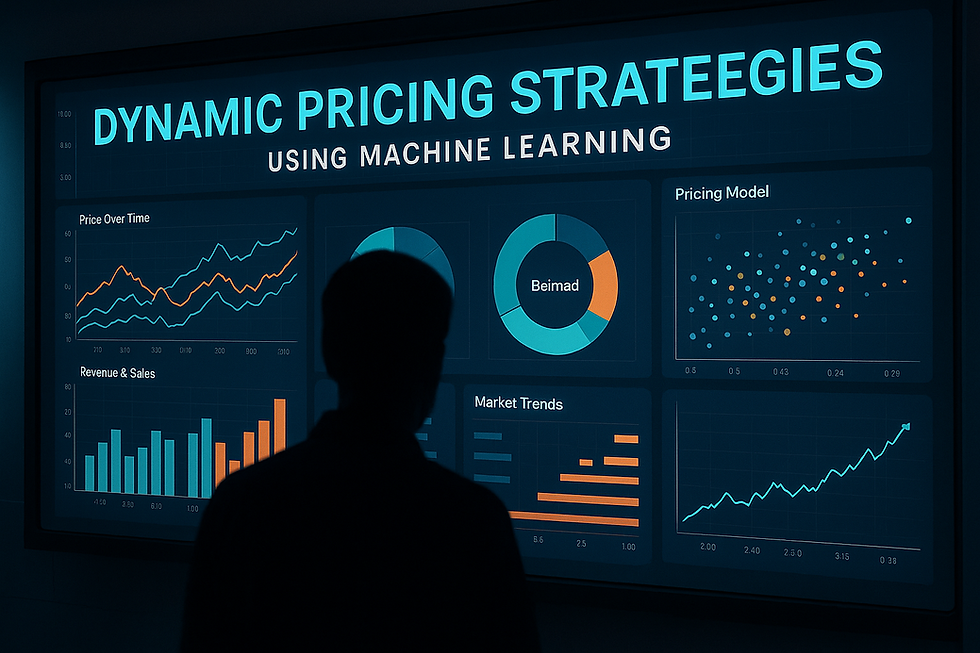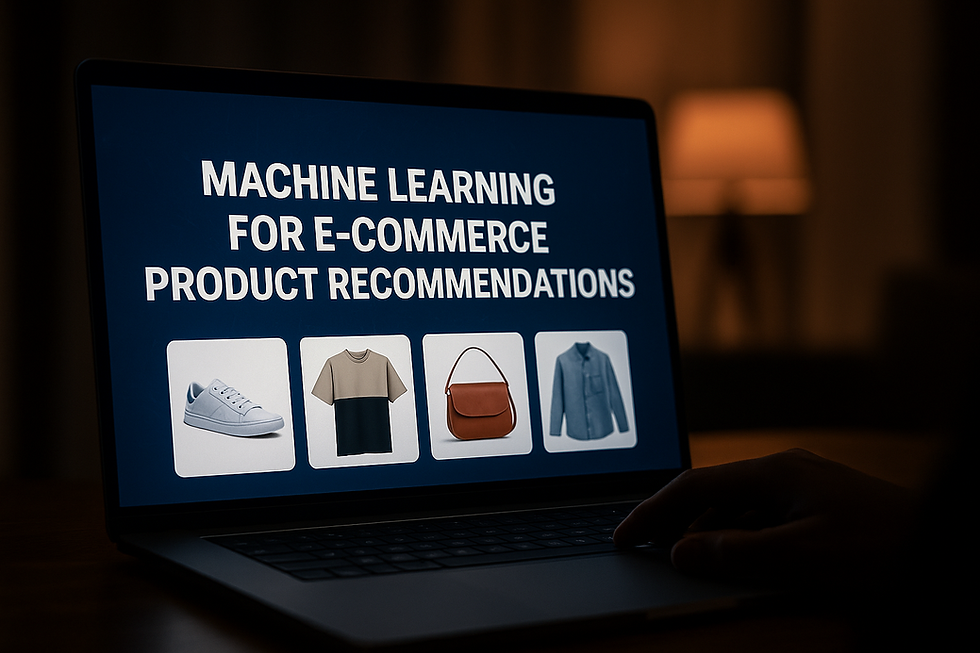Dynamic Pricing Strategies Using Machine Learning
- Muiz As-Siddeeqi

- Aug 28
- 5 min read

Dynamic Pricing Strategies Using Machine Learning
We Don’t Set Prices Anymore – We Predict Them Now
If you’re still pricing your products the old way — spreadsheets, gut-feel, seasonal hunches — we have to be honest: you're bleeding revenue. You may not see it in your bank statements, but you’re leaving piles of money on the table... daily. Meanwhile, brands like Amazon, Uber, Airbnb, and even Walmart are quietly reaping billions by letting algorithms — not humans — do the pricing.
This blog isn’t theory. It’s an exposé of real-world, documented dynamic pricing strategies used by companies that are not just dominating their industries — they’re reinventing the meaning of pricing altogether using machine learning.
Let’s unravel what’s really happening under the hood.
Bonus: Machine Learning in Sales: The Ultimate Guide to Transforming Revenue with Real-Time Intelligence
Machine Learning Isn’t Helping with Pricing… It’s Owning It
Traditional pricing once depended on human-crafted rules like:
“Give a 10% discount during festive seasons”
“Increase the price if demand spikes by 20%”
“Match competitors manually every week”
That world is gone.
Now, machine learning (ML) does something revolutionary: it continuously learns from:
Competitor prices (scraped every few hours)
User behavior (clicks, scrolls, time on page)
Inventory levels
Time of day
Weather
Even your customer’s device model
And then — all by itself — the algorithm adjusts prices in real-time, optimizing for margin, revenue, or conversions.
This isn’t speculation. Let’s get into the cold, hard proof.
Proof from the Frontlines: Real Stats, Real Billions
1. Amazon’s Pricing Algorithms Change Prices Every 10 Minutes
According to Profitero's 2024 eCommerce Pricing Study, Amazon changes prices for over 2.5 million products per day, dynamically adjusting based on competitor price crawlers and purchase behavior. [Source: Profitero, 2024]
That’s over 150 price updates per product per week.
Amazon’s dynamic pricing model is powered by Reinforcement Learning, a subset of ML that uses real-time feedback (sales volume, time to sale, competitor reaction) to learn which pricing strategy works best.
Result? Amazon grew its net revenue from $280.5B in 2019 to $524.9B in 2023 — an increase of nearly 87% in just 4 years [Source: Amazon Annual Report 2023].
2. Uber’s “Surge Pricing” Is Powered by Gradient Boosted Models
Uber’s system detects spikes in demand using ride request volumes, location density, and rider-driver ratios. It then uses XGBoost (Extreme Gradient Boosting) to predict optimal fare multipliers in real time.
A published case study by Uber’s engineering team (2023) revealed that their Machine Learning pricing engine increased driver availability by 13% and improved ride completion rate by 17% during high-demand events [Source: Uber Engineering Blog, 2023].
Hidden Algorithms Behind Pricing — How It Works, For Real
Let’s break it down simply, without tech jargon:
Data Collection
The system collects:
Your product views
Past purchase history
Cart abandonment trends
Geo-location
Competitor prices (via web scraping)
Feature Engineering
Transforms raw data into signals:
“Is this customer a returning visitor?”
“How often does this product sell during weekends?”
“Are competitors currently offering lower prices?”
Model Selection
ML models such as:
Random Forest Regressors (for price sensitivity)
XGBoost (for margin optimization)
Neural Networks (for real-time personalization)
Prediction & Action
The model then predicts the optimal price that will either:
Maximize revenue
Maximize conversion
Or maximize profit margin
Continuous Learning
After every sale (or lack of sale), it learns and updates.
This loop happens millions of times a day on large-scale eCommerce platforms.
Real-World Case Studies That Redefined the Game
Walmart’s ML Pricing Transformation
Walmart partnered with ClearDemand and later adopted in-house ML pricing to price over 245,000 SKUs dynamically. According to a report in Harvard Business Review (2022), Walmart’s AI-based dynamic pricing improved their pricing accuracy and contributed to a $2.4 billion increase in eCommerce revenue [Source: HBR, 2022].
Their models consider:
Online competitor prices
Real-time demand surges
Inventory depletion rates
Airbnb’s Smart Pricing Tool
Airbnb’s “Smart Pricing” algorithm considers:
Booking trends
Seasonality
Local events (e.g., concerts, festivals)
Competitor rates (from Booking.com, VRBO)
A study published in Journal of Revenue & Pricing Management (2021) found that listings using Smart Pricing experienced up to 16% higher occupancy rates and 14% higher total revenue, compared to manual pricing hosts [Source: SpringerLink].
How Startups and SMBs Are Using This (It’s Not Just for Giants)
Case: Dynamic Pricing for D2C Brand “True Classic”
True Classic, a U.S.-based men's clothing D2C brand, integrated ML-driven pricing via Pricemoov, adjusting bundle discounts and flash sale pricing in real-time.
According to a Forrester Consulting TEI Study (2023), they achieved:
8.2% increase in average order value
12.5% reduction in discount leakage
3.4% margin increase within 6 months
And they’re not the only ones — Shopify Plus users are integrating Intelligems, BlackCurve, and Reactful AI for real-time dynamic pricing without needing a massive in-house data science team.
The Real Building Blocks of ML-Powered Pricing
Pricing Models: Elastic vs Inelastic Demand
Dynamic ML pricing thrives on one question: How sensitive is your customer to price changes?
ML learns this by A/B testing price changes in the wild — feeding it back into its decision-making loop. Elasticity curves are built from real-time user behavior, not theoretical assumptions.
Price Discrimination: Yes, Legally
ML enables “First-Degree Price Discrimination” — adjusting prices per individual based on willingness to pay. This is legal in most jurisdictions if:
It doesn’t discriminate based on protected attributes (gender, race, etc.)
It’s transparent in privacy policies
Retailers like Staples.com were shown in a WSJ investigation (2012) to vary pricing based on proximity to competitor stores. [Source: Wall Street Journal, 2012]
Legal & Ethical Guardrails (Yes, You Need These)
Dynamic pricing is powerful — but unchecked, it can backfire hard.
GDPR and Price Personalization
Under the EU’s GDPR laws, pricing algorithms must:
Offer explainability — why was this price shown?
Avoid automated discrimination
Let users opt out of profiling
The EU Commission fined Amazon €1.13 billion in 2022 for anti-competitive practices partially related to unfair algorithmic pricing behavior in the Buy Box context [Source: European Commission, 2022].
Make sure your ML models are:
Auditable
Non-discriminatory
Compliant with privacy laws
How to Start Implementing It (Even Without a Data Team)
Step-by-Step for Smaller Brands:
Start Tracking
Use Google Analytics, Hotjar, or Mixpanel to track:
Page views
Time on pricing pages
Cart abandonment patterns
Choose the Right Tool
Use plug-and-play tools like:
Prisync
Pricefx
BlackCurve
Wiser Solutions
Run Experiments
Begin with A/B testing:
Static price vs ML suggested price
Real-time discounting on abandoned carts
Feed Data Back
Let tools learn from CTRs, conversion drops, upsell success.
Monitor Legally
Document every rule and every price change rationale — for audits.
The Emotional Reality: Pricing is Psychological Warfare
Dynamic pricing isn’t just math. It plays with human psychology.
Too high, you alienate.
Too low, you devalue.
Too static, you become predictable.
Machine learning thrives on this paradox. It doesn’t guess — it learns the customer’s behavior in real-time. The price you see today? It wasn’t set. It was learned, just for you.
And that — is where the future of sales is going.
Final Word from the Field
If we could summarize the reality in one sentence:
Dynamic pricing with machine learning is not a luxury — it’s a survival strategy.
Every company using ML to price is pulling ahead. Those that aren't? They’re already being priced out of the game.
There’s no “later” in this. Either your prices evolve in real-time, or your business becomes part of someone else's training dataset.

$50
Product Title
Product Details goes here with the simple product description and more information can be seen by clicking the see more button. Product Details goes here with the simple product description and more information can be seen by clicking the see more button

$50
Product Title
Product Details goes here with the simple product description and more information can be seen by clicking the see more button. Product Details goes here with the simple product description and more information can be seen by clicking the see more button.

$50
Product Title
Product Details goes here with the simple product description and more information can be seen by clicking the see more button. Product Details goes here with the simple product description and more information can be seen by clicking the see more button.






Comments